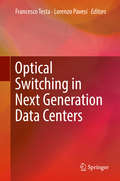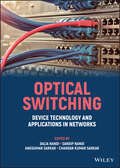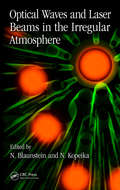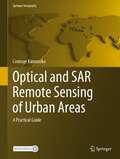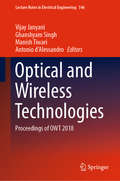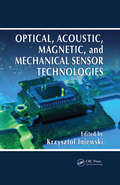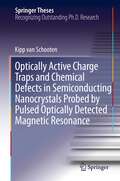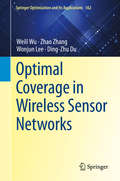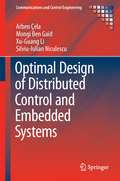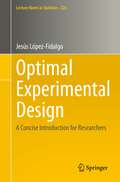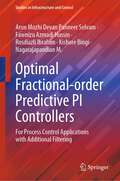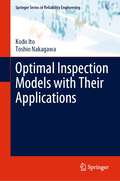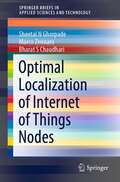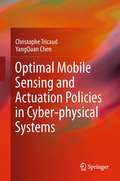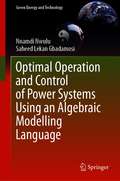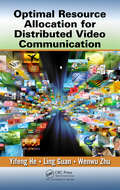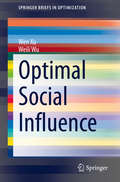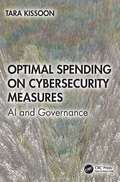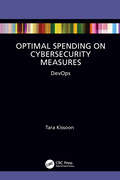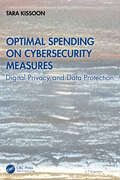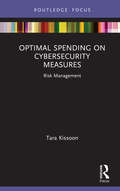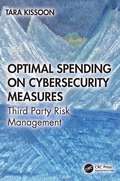- Table View
- List View
Optical Switching in Next Generation Data Centers
by Lorenzo Pavesi Francesco TestaThis book introduces the reader to the optical switching technology for its application to data centers. In addition, it takes a picture of the status of the technology and system architecture evolution and of the research in the area of optical switching in data center. The book is organized in four parts: the first part is focused on the system aspects of optical switching in intra-data center networking, the second part is dedicated to describing the recently demonstrated optical switching networks, the third part deals with the latest technologies developed to enable optical switching and, finally, the fourth part of the book outlines the future prospects and trends.
Optical Switching: Device Technology and Applications in Networks
by Chandan Kumar Sarkar Dalia Nandi Sandip Nandi Angsuman SarkarOPTICAL SWITCHING Comprehensive coverage of optical switching technologies and their applications in optical networks Optical Switching: Device Technology and Applications in Networks delivers an accessible exploration of the evolution of optical networks with clear explanations of the current state-of-the-art in the field and modern challenges in the development of Internet-of-Things devices. A variety of optical switches—including MEMS-based, magneto, photonic, and SOA-based—are discussed, as is the application of optical switches in networks. The book is written in a tutorial style, easily understood by both undergraduate and graduate students. It describes the fundamentals and recent developments in optical switch networks and examines the architectural and design challenges faced by those who design and construct emerging optical switch networks, as well as how to overcome those challenges. The book offers ways to assess and analyze systems and applications, comparing a variety of approaches available to the reader. It also provides: A thorough introduction to switch characterization, including optical, electro optical, thermo optical, magneto optical, and acoustic-optic switches Comprehensive explorations of MEMS-based, SOA-based, liquid crystal, photonic crystal, and optical electrical optical (OEO) switches Practical discussions of quantum optical switches, as well as nonlinear optical switches In-depth examinations of the application of optical switches in networks, including switch fabric control and optical switching for high-performance computing Perfect for researchers and professionals in the fields of telecommunications, Internet of Things, and optoelectronics, Optical Switching: Device Technology and Applications in Networks will also earn a place in the libraries of advanced undergraduate and graduate students studying optical networks, optical communications, and sensor applications.
Optical Waves and Laser Beams in the Irregular Atmosphere
by Nathan Blaunstein and Natan KopeikaThe book introduces optical wave propagation in the irregular turbulent atmosphere and the relations to laser beam and LIDAR applications for both optical communication and imaging. It examines atmosphere fundamentals, structure, and content. It explains specific situations occurring in the irregular atmosphere and for specific natural phenomena that affect optical ray and laser beam propagation. It emphasizes how to use LIDAR to investigate atmospheric phenomena and predict primary parameters of the irregular turbulent atmosphere and suggests what kinds of optical devices to operate in different atmospheric situations to minimize the deleterious effects of natural atmospheric phenomena.
Optical Wireless Communications: IR for Wireless Connectivity
by Roberto Ramirez-Iniguez Sevia M. Idrus Ziran SunOver the last three decades, interest in Infrared (IR) technology as a medium to convey information has grown considerably. This is reflected by the increasing number of devices such as laptops, PDAs, and mobile phones that incorporate optical wireless transceivers and also by the increasing number of optical wireless links available for indoor and
Optical and SAR Remote Sensing of Urban Areas: A Practical Guide (Springer Geography)
by Courage KamusokoThis book introduces remotely sensed image processing for urban areas using optical and synthetic aperture radar (SAR) data and assists students, researchers, and remote sensing practitioners who are interested in land cover mapping using such data. There are many introductory and advanced books on optical and SAR remote sensing image processing, but most of them do not serve as good practical guides. However, this book is designed as a practical guide and a hands-on workbook, where users can explore data and methods to improve their land cover mapping skills for urban areas. Although there are many freely available earth observation data, the focus is on land cover mapping using Sentinel-1 C-band SAR and Sentinel-2 data. All remotely sensed image processing and classification procedures are based on open-source software applications such QGIS and R as well as cloud-based platforms such as Google Earth Engine (GEE). The book is organized into six chapters. Chapter 1 introduces geospatial machine learning, and Chapter 2 covers exploratory image analysis and transformation. Chapters 3 and 4 focus on mapping urban land cover using multi-seasonal Sentinel-2 imagery and multi-seasonal Sentinel-1 imagery, respectively. Chapter 5 discusses mapping urban land cover using multi-seasonal Sentinel-1 and Sentinel-2 imagery as well as other derived data such as spectral and texture indices. Chapter 6 concludes the book with land cover classification accuracy assessment.
Optical and Wireless Technologies: Proceedings of OWT 2018 (Lecture Notes in Electrical Engineering #546)
by Ghanshyam Singh Vijay Janyani Manish Tiwari Antonio D’AlessandroThis volume presents selected papers from the 2nd International Conference on Optical and Wireless Technologies, conducted from 10th to 11th February, 2018. It focuses on extending the limits of currently used systems encompassing optical and wireless domains, and explores novel research on wireless and optical techniques and systems, describing practical implementation activities, results and issues. The book will serve as a valuable reference resource for academics and researchers across the globe.
Optical and Wireless Technologies: Proceedings of OWT 2019 (Lecture Notes in Electrical Engineering #648)
by Ghanshyam Singh Vijay Janyani Manish Tiwari Tawfik IsmailThis volume presents selected papers from the 3rd International Conference on Optical and Wireless Technologies, conducted from 16th to 17th March, 2019. It focuses on extending the limits of currently used systems encompassing optical and wireless domains, and explores the latest developments in applications like photonics, high speed communication systems and networks, visible light communication, nano-photonics, wireless, and MIMO systems. The proceedings contain high quality scholarly articles, giving insight into the analytical, experimental, and developmental aspects of systems, techniques, and devices in these spheres. This volume will prove useful to researchers and professionals alike.
Optical, Acoustic, Magnetic, and Mechanical Sensor Technologies (Devices, Circuits, and Systems)
by Krzysztof IniewskiLight on physics and math, with a heavy focus on practical applications, Optical, Acoustic, Magnetic, and Mechanical Sensor Technologies discusses the developments necessary to realize the growth of truly integrated sensors for use in physical, biological, optical, and chemical sensing, as well as future micro- and nanotechnologies. Used to pick up sound, movement, and optical or magnetic signals, portable and lightweight sensors are perpetually in demand in consumer electronics, biomedical engineering, military applications, and a wide range of other sectors. However, despite extensive existing developments in computing and communications for integrated microsystems, we are only just now seeing real transformational changes in sensors, which are critical to conducting so many advanced, integrated tasks. This book is designed in two sections—Optical and Acoustic Sensors and Magnetic and Mechanical Sensors—that address the latest developments in sensors. The first part covers: Optical and acoustic sensors, particularly those based on polymer optical fibers Potential of integrated optical biosensors and silicon photonics Luminescent thermometry and solar cell analyses Description of research from United States Army Research Laboratory on sensing applications using photoacoustic spectroscopy Advances in the design of underwater acoustic modems The second discusses: Magnetic and mechanical sensors, starting with coverage of magnetic field scanning Some contributors’ personal accomplishments in combining MEMS and CMOS technologies for artificial microsystems used to sense airflow, temperature, and humidity MEMS-based micro hot-plate devices Vibration energy harvesting with piezoelectric MEMS Self-powered wireless sensing As sensors inevitably become omnipresent elements in most aspects of everyday life, this book assesses their massive potential in the development of interfacing applications for various areas of product design and sciences—including electronics, photonics, mechanics, chemistry, and biology, to name just a few.
Optically Active Charge Traps and Chemical Defects in Semiconducting Nanocrystals Probed by Pulsed Optically Detected Magnetic Resonance
by Kipp Van SchootenColloidal nanocrystals show much promise as an optoelectronics architecture due to facile control over electronic properties afforded by chemical control of size, shape, and heterostructure. Unfortunately, realizing practical devices has been forestalled by the ubiquitous presence of charge "trap" states which compete with band-edge excitons and result in limited device efficiencies. Little is known about the defining characteristics of these traps, making engineered strategies for their removal difficult. This thesis outlines pulsed optically detected magnetic resonance as a powerful spectroscopy of the chemical and electronic nature of these deleterious states. Counterintuitive for such heavy atom materials, some trap species possess very long spin coherence lifetimes (up to 1.6 µs). This quality allows use of the trapped charge's magnetic moment as a local probe of the trap state itself and its local environment. Beyond state characterization, this spectroscopy can demonstrate novel effects in heterostructured nanocrystals, such as spatially-remote readout of spin information and the coherent control of light harvesting yield.
Optimal Coverage in Wireless Sensor Networks (Springer Optimization and Its Applications #162)
by Ding-Zhu Du Weili Wu Zhao Zhang Wonjun LeeThis book will serve as a reference, presenting state-of-the-art research on theoretical aspects of optimal sensor coverage problems. Readers will find it a useful tool for furthering developments on theory and applications of optimal coverage; much of the content can serve as material for advanced topics courses at the graduate level. The book is well versed with the hottest research topics such as Lifetime of Coverage, Weighted Sensor Cover, k-Coverage, Heterogeneous Sensors, Barrier, Sweep and Partial Coverage, Mobile Sensors, Camera Sensors and Energy-Harvesting Sensors, and more. Topics are introduced in a natural order from simple covers to connected covers, to the lifetime problem. Later, the book begins revisiting earlier problems ranging from the introduction of weights to coverage by k sensors and partial coverage, and from sensor heterogeneity to novel problems such as the barrier coverage problem. The book ends with coverage of mobile sensors, camera sensors, energy-harvesting sensors, underwater sensors, and crowdsensing.
Optimal Design of Distributed Control and Embedded Systems
by Silviu-Iulian Niculescu Xu-Guang Li Arben Çela Mongi Ben GaidOptimal Design of Distributed Control and Embedded Systems focuses on the design of special control and scheduling algorithms based on system structural properties as well as on analysis of the influence of induced time-delay on systems performances. It treats the optimal design of distributed and embedded control systems (DCESs) with respect to communication and calculation-resource constraints, quantization aspects, and potential time-delays induced by the associated communication and calculation model. Particular emphasis is put on optimal control signal scheduling based on the system state. In order to render this complex optimization problem feasible in real time, a time decomposition is based on periodicity induced by the static scheduling is operated. The authors present a co-design approach which subsumes the synthesis of the optimal control laws and the generation of an optimal schedule of control signals on real-time networks as well as the execution of control tasks on a single processor. The authors also operate a control structure modification or a control switching based on a thorough analysis of the influence of the induced time-delay system influence on stability and system performance in order to optimize DCES performance in case of calculation and communication resource limitations. Although the richness and variety of classes of DCES preclude a completely comprehensive treatment or a single "best" method of approaching them all, this co-design approach has the best chance of rendering this problem feasible and finding the optimal or some sub-optimal solution. The text is rounded out with references to such applications as car suspension and unmanned vehicles. Optimal Design of Distributed Control and Embedded Systems will be of most interest to academic researchers working on the mathematical theory of DCES but the wide range of environments in which they are used also promotes the relevance of the text for control practitioners working in the avionics, automotive, energy-production, space exploration and many other industries.
Optimal Experimental Design: A Concise Introduction for Researchers (Lecture Notes in Statistics #226)
by Jesús López-FidalgoThis textbook provides a concise introduction to optimal experimental design and efficiently prepares the reader for research in the area. It presents the common concepts and techniques for linear and nonlinear models as well as Bayesian optimal designs. The last two chapters are devoted to particular themes of interest, including recent developments and hot topics in optimal experimental design, and real-world applications. Numerous examples and exercises are included, some of them with solutions or hints, as well as references to the existing software for computing designs. The book is primarily intended for graduate students and young researchers in statistics and applied mathematics who are new to the field of optimal experimental design. Given the applications and the way concepts and results are introduced, parts of the text will also appeal to engineers and other applied researchers.
Optimal Fractional-order Predictive PI Controllers: For Process Control Applications with Additional Filtering (Studies in Infrastructure and Control)
by Rosdiazli Ibrahim Kishore Bingi Arun Mozhi Panneer Selvam Fawnizu Azmadi Hussin Nagarajapandian M.This book presents the study to design, develop, and implement improved PI control techniques using dead-time compensation, structure enhancements, learning functions and fractional ordering parameters. Two fractional-order PI controllers are proposed and designed: fractional-order predictive PI and hybrid iterative learning based fractional-order predictive PI controller. Furthermore, the proposed fractional-order control strategies and filters are simulated over first- and second-order benchmark process models and further validated using the real-time experimentation of the pilot pressure process plant. In this book, five chapters are structured with a proper sequential flow of details to provide a better understanding for the readers. A general introduction to the controllers, filters and optimization techniques is presented in Chapter 1. Reviews of the PI controllers family and their modifications are shown in the initial part of Chapter 2, followed by the development of the proposed fractional-order predictive PI (FOPPI) controller with dead-time compensation ability. In the first part of chapter 3, a review of the PI based iterative learning controllers, modified structures of the ILC and their modifications are presented. Then, the design of the proposed hybrid iterative learning controller-based fractional-order predictive PI controller based on the current cyclic feedback structure is presented. Lastly, the results and discussion of the proposed controller on benchmark process models and the real-time experimentation of the pilot pressure process plant are given. Chapter 4 presents the development of the proposed filtering techniques and their performance comparison with the conventional methods. Chapter 5 proposes the improvement of the existing sine cosine algorithm (SCA) and arithmetic optimization algorithm (AOA) to form a novel arithmetic-trigonometric optimization algorithm (ATOA) to accelerate the rate of convergence in lesser iterations with mitigation towards getting caught in the same local position. The performance analysis of the optimization algorithm will be carried out on benchmark test functions and the real-time pressure process plant.
Optimal Inspection Models with Their Applications (Springer Series in Reliability Engineering)
by Toshio Nakagawa Kodo ItoThis book surveys recent applications of inspection models, maintenance models and cumulative damage models, as well as discusses the policies involved with these models. It explains how a stochastic approach can be applied to systems using real-world examples.The book begins by introducing and summarizing standard inspection models. It dedicates chapters to random inspection models and general inspection models, before moving on to discuss inspection policies and checkpoint models. The book discusses inspection of reliability systems, such as missile maintenance systems, as well as Markov models of inspection. The book concludes with a summary of other inspection models, problems they face, and solutions to these problems. Each chapter utilizes examples to illustrate the various models, methods, and policies. This book is of interest to engineering students, researchers, and design and production engineers working in system manufacturing.
Optimal Localization of Internet of Things Nodes (SpringerBriefs in Applied Sciences and Technology)
by Marco Zennaro Sheetal N Ghorpade Bharat S ChaudhariThis book is a practical resource for designing Internet of Things (IoT) networks and implementing IoT applications from the localization perspective. With the emergence of IoT, machine to machine communication, Industrial IoT, and other societal applications, many applications require knowledge of the exact location of mobile IoT nodes in real-time. As the IoT nodes have computational and energy limitations, it is a crucial research challenge to optimize the network's performance with the highest localization accuracy. Many researchers are working towards such localization problems. However, there is no single book available for the detailed study on IoT node localization. This book provides one-stop multidisciplinary solutions for IoT node localization, design requirements, challenges, constraints, available techniques, comparison, related applications, and future directions. Special features included are theory supported by algorithmic development, treatment of optimization techniques, and applications.
Optimal Mobile Sensing and Actuation Policies in Cyber-physical Systems
by Yangquan Chen Christophe TricaudA successful cyber-physical system, a complex interweaving of hardware and software with some part of the physical environment, depends on proper identification of the, often pre-existing, physical element. A bespoke "cyber" part of the system may then be designed from scratch. Optimal Mobile Sensing and Actuation Strategies in Cyber-physical Systems focuses on distributed-parameter systems the dynamics of which can be modelled with partial differential equations. These are very challenging to observe, their states and inputs being distributed throughout a spatial domain. Consequently, systematic approaches to the optimization of sensor location have to be devised for parameter estimation. The text begins by reviewing the field of cyber-physical systems and introducing background notions of distributed parameter systems and optimal observation theory. New research problems are then defined within this framework. Two important problems considered are optimal mobile sensor trajectory planning and the accuracy effects and allocation of remote sensors. These are followed up with a solution to the problem of optimal robust estimation. Actuation policies are then introduced into the framework with the purpose of improving estimation and optimizing the trajectories of both sensors and actuators simultaneously. The large number of illustrations within the text will assist the reader to visualize the application of the methods proposed. A group of similar examples are used throughout the book to help the reader assimilate the material more easily. The monograph concentrates on the use of methods for which a cyber-physical-systems infrastructure is required. The methods are computationally heavy and require mobile sensors and actuators with communications abilities. Application examples cover fields from environmental science to national security so that readers are encouraged to link the ideas of cyber-physical systems with their own research.
Optimal Operation and Control of Power Systems Using an Algebraic Modelling Language (Green Energy and Technology)
by Nnamdi Nwulu Saheed Lekan GbadamosiThis book presents mathematical models of demand-side management programs, together with operational and control problems for power and renewable energy systems. It reflects the need for optimal operation and control of today’s electricity grid at both the supply and demand spectrum of the grid. This need is further compounded by the advent of smart grids, which has led to increased customer/consumer participation in power and renewable energy system operations. The book begins by giving an overview of power and renewable energy systems, demand-side management programs and algebraic modeling languages. The overview includes detailed consideration of appliance scheduling algorithms, price elasticity matrices and demand response incentives. Furthermore, the book presents various power system operational and control mathematical formulations, incorporating demand-side management programs. The mathematical formulations developed are modeled and solved using the Advanced Interactive Multidimensional Modeling System (AIMMS) software, which offers a powerful yet simple algebraic modeling language for solving optimization problems. The book is extremely useful for all power system operators and planners who are concerned with optimal operational procedures for managing today’s complex grids, a context in which customers are active participants and can curb/control their demand. The book details how AIMMS can be a useful tool in optimizing power grids and also offers a valuable research aid for students and academics alike.
Optimal Resource Allocation for Distributed Video Communication
by Ling Guan Wenwu Zhu Yifeng HeFocusing on resource optimization for distributed video and multimedia communications, this book examines four applications in optimal resource allocations with distributed algorithms, including problem formulation, theoretical analysis, and simulation results. Suitable for both industry practitioners and academics, it introduces the characteristics, recent advances, and current challenges in distributed systems as well as a solutions framework to tackle those challenges. Discussing cutting-edge topics such as the theory of convex optimization and the development of a distributed algorithm using dual decomposition, the book concludes with open issues to stimulate further learning.
Optimal Social Influence (SpringerBriefs in Optimization)
by Weili Wu Wen XuThis self-contained book describes social influence from a computational point of view, with a focus on recent and practical applications, models, algorithms and open topics for future research. Researchers, scholars, postgraduates and developers interested in research on social networking and the social influence related issues will find this book useful and motivating. The latest research on social computing is presented along with and illustrations on how to understand and manipulate social influence for knowledge discovery by applying various data mining techniques in real world scenarios. Experimental reports, survey papers, models and algorithms with specific optimization problems are depicted. The main topics covered in this book are: chrematistics of social networks, modeling of social influence propagation, popular research problems in social influence analysis such as influence maximization, rumor blocking, rumor source detection, and multiple social influence competing.
Optimal Spending on Cybersecurity Measures: AI and Governance
by Tara KissoonThe aim of this book is to demonstrate the use of business‑driven risk assessments to address government regulations and guidelines specific to AI risks, as AI systems often require access to personal data. All aspects of AI, machine learning models, continuous learning, generalization, and predictive and descriptive analytics are dependent on massive datasets. The more diverse and comprehensive the data, the better an AI can perform. Therefore, AI systems require vast amounts of personal data, and should this data be accessed by unauthorized individuals or organizations, it will lead to a privacy breach, which may result in personal harm to citizens, i.e., identity theft.This book introduces the cyber risk investment model and the cybersecurity risk management framework used within business‑driven risk assessments to address government regulations, industry standards, and applicable laws. It can be used by various stakeholders who are involved in the implementation of cybersecurity measures to safeguard sensitive data. This framework facilitates an organization’s risk management decision‑making process to demonstrate the mechanisms in place to fund cybersecurity measures and demonstrates the application of the process by showcasing two case studies.Features: Aims to strengthen the reader’s understanding of industry governance, AI risk, and compliance practices. Incorporates an innovative approach to assess business risk management specific to AI systems. Explores the strategic decisions made by organizations when implementing cybersecurity measures and leverages an integrated approach to include risk management elements.
Optimal Spending on Cybersecurity Measures: DevOps
by Tara KissoonOptimal Spending on Cybersecurity Measures: DevOps aims to discuss the integration of risk management methodologies within the DevOps process.This book introduces the cyber risk investment model, and the cybersecurity risk management framework within the DevOps process. This can be used by various stakeholders who are involved in the implementation of cybersecurity measures to safeguard sensitive data. This framework facilitates an organization’s risk management decision-making process to demonstrate the mechanisms in place to fund cybersecurity measures within DevOps practices, and demonstrates the application of the process using a case study: Cascade. This book also discusses the elements used within DevOps, DevSecOps, and will define a strategic approach to minimize cybersecurity risks within DevOps known as DevRiskOps.Features: Aims to strengthen the reader’s understanding of industry governance, risk and compliance practices. Incorporates an innovative approach to assess cyber security initiatives with DevOps. Explores the strategic decisions made by organizations when implementing cybersecurity measures and leverages an integrated approach to include risk management elements into DevOps.
Optimal Spending on Cybersecurity Measures: Digital Privacy and Data Protection
by Tara KissoonThe aim of this book is to demonstrate the use of business- driven risk assessments to meet the requirements within privacy laws. This book introduces the cyber risk investment model and the cybersecurity risk management framework used within business-driven risk assessments to meet the intent of privacy and data protection laws. This can be used by various stakeholders involved in the implementation of cybersecurity measures to safeguard sensitive data. This framework facilitates an organization’s risk management decision- making process to demonstrate the mechanisms in place to fund cybersecurity measures to meet privacy laws and demonstrates the application of the process using two case studies: CatchMyData and Rapid Cloud Migration. This book also discusses the elements used within the cybersecurity risk management process and defines a strategic approach to minimize cybersecurity risks. Features Aims to strengthen the reader’s understanding of industry governance, risk and compliance practices Incorporates an innovative approach to assess business risk management Explores the strategic decisions made by organizations when implementing cybersecurity measures and leverages an integrated approach to include risk management elements
Optimal Spending on Cybersecurity Measures: Protecting Health Information
by Tara KissoonThe aim of this book is to demonstrate the use of business-driven risk assessments within the privacy impact assessment process to meet the requirements of privacy laws.This book introduces the cyber risk investment model, and the cybersecurity risk management framework used within business-driven risk assessments to meet the intent of Privacy and Data Protection Laws. These can be used by various stakeholders who are involved in the implementation of cybersecurity measures to safeguard sensitive data. This framework facilitates an organization’s risk management decision-making process to demonstrate the mechanisms in place to fund cybersecurity measures to comply with Privacy Laws and demonstrates the application of the process by showcasing six case studies. This book also discusses the elements used within the cybersecurity risk management process and defines a strategic approach to minimize cybersecurity risks.Features: Aims to strengthen the reader’s understanding of industry governance, risk and compliance practices. Incorporates an innovative approach to assess business risk management. Explores the strategic decisions made by organizations when implementing cybersecurity measures and leverages an integrated approach to include risk management elements.
Optimal Spending on Cybersecurity Measures: Risk Management (Routledge Focus on Business and Management)
by Tara KissoonThis book explores the strategic decisions made by organizations when implementing cybersecurity controls and leveraging economic models and theories from the economics of information security and risk-management frameworks. Based on unique and distinct research completed within the field of risk-management and information security, this book provides insight into organizational risk management processes utilized in determining cybersecurity investments. It describes how theoretical models and frameworks rely on either specific scenarios or controlled conditions and how decisions on cybersecurity spending within organizations, specifically the funding available in comparison to the recommended security measures necessary for compliance, vary depending on stakeholders. As the trade-off between the costs of implementing a security measure and the benefit derived from the implementation of security controls is not easily measured, a business leader’s decision to fund security measures may be biased. The author presents an innovative approach to assess cyber security initiatives with a risk-management perspective and leverages a data-centric focus on the evolution of cyber-attacks. This book is ideal for business school students and technology professionals with an interest in risk management.
Optimal Spending on Cybersecurity Measures: Third Party Risk Management
by Tara KissoonThis book aims to demonstrate the use of business‑driven risk assessments to address government regulations and guidelines specific to the management of risks related to all third‑party arrangements and emphasises that organisations retain accountability for business activities, functions and services outsourced to a third party.This book introduces the cyber risk investment model and the cybersecurity risk management framework used within business‑driven risk assessments to address government regulations, industry standards and applicable laws. This can be used by various stakeholders who are involved in the implementation of cybersecurity measures to safeguard sensitive data. This framework facilitates an organisation’s risk management decision‑making process to demonstrate the mechanisms in place to fund cybersecurity measures and demonstrates the application of the process showcasing three case studies. This book also discusses the elements used within the cybersecurity risk management process and defines a strategic approach to minimise cybersecurity risks.Features: Aims to strengthen the reader’s understanding of industry governance, risk and compliance practices. Incorporates an innovative approach to assess business risk management. Explores the strategic decisions made by organisations when implementing cybersecurity measures and leverages an integrated approach to include risk management elements.
